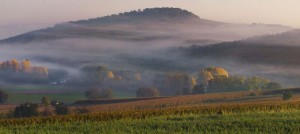Though most people say they like dry wine, until now we haven’t been able to find that many good German dry Rieslings. This week I tried several, from famed Dr. Loosen. (They still make the traditional Rieslings too, don’t worry.) One evening, Luiz Alberto (@TheWineHub) came over and tasted with me.
I found that all the wines had good acidity and some finesse. We paired the wines with pork loin with gravy, accompanied by oven-roasted root vegs sparked with dried cranberries. Sweet and savory together. And this did interesting things to the wines – some better, some not.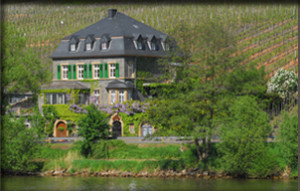
Before dinner, my fave was the 2012 Urziger Wurzgarten Riesling Alte Reben GG ($42) from the steepest of grand cru vineyards, planted with old vines known for their spiciness. It’s a big wine, with finesse and complexity, that feels fully mature even now. Though the official tasting notes mention tropical fruits, I found flavors reminded me of fruit leather made with stone fruit. This was accompanied by hints of baking spices on the mid- and end-palate and in the finish, too. In the end, I enjoyed this wine much more on its own than with dinner because the finesse got lost in these foods. So the next night I sipped the wine on its own: excellent!
Dr. Loosen’s 2012 Wehlener Sonnenhur Riesling GG ($42) was a bit milder, having been aged in larger, more neutral oak for a shorter period of time. This grand cru vineyard is blue slate, producing a wine with lots of minerality and acidity, and stone fruit flavors. This would require more delicate pairings than our hearty winter food – or perhaps with no food at all.
The 2012 Erdener Treppchen Riesling GG Alte Reben ($42) is from a grand cru vineyard on red slate, with old vines. Though the aromas were (typically) slight, the wine was a little sweeter, with flavors of candied grapefruit on the palate and in the moderate finish: a rather delicate wine — unfortunately too delicate to pair with our dinner that night. The next night it paired well with very simple crabcakes.
Then there was the youngest wine, the 2013 Reisling Dry “Red Slate,†produced in neutral oak with native yeasts, just as Ernie Loosen’s grandfather used to do. It opens ($18) with spritzy acidity, has ripe stone fruit on the palate and a longish finish. This wine ended up being the favorite of the evening, as it opened into an enriching match for the food – at a good price, too.
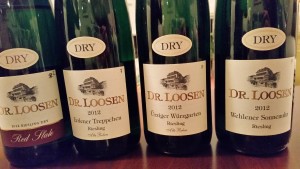
Blog
Tuscan Red Wines for Today and Tomorrow: Three Different Styles of Sangiovese for Winter
From the 700-year-old Frescobaldi family, here are three wines I liked from a recent (virtual) Tuscan tasting with the Frescobaldi family. The wines are all made with the sangiovese grape, but in different areas, with different results.
Interestingly, all three wines were all even better the next day – fuller and more intense.
The clear, garnet-purple 2010 Nipozzano Riserva (around $20) is a Chianti DOCG from Rufina, its high altitude aiding in the wine’s natural high acidity. The Marchese di Frescobaldi calls it a good palate cleansing wine to accompany winter’s rich meat dishes. With florals and dark fruit in the aroma, it segues to “wild cherry†and some herbal notes on the palate, and a good finish; pair with herbed pork, or beef.
Though the 2011 Montesodi ($40) also comes from Nipozzano, it has a designation of Castello di Nipozzano Toscana IGT, which means the wine can be made with different parameters than if it was a Chianti, for example. This wine happens to be made with 100% Sangiovese. Since 1974, it has only been made in the best years, with specially selected grapes. It also has some florals in the aroma, but it’s a plump, juicy wine full of dark red fruit. Big on the palate but also elegant. Good acidity which is not readily apparent but drives you to take another sip, and another. The Marchese says to pair it with veal and a really good potato dish, but most of all “with great company.â€
Moving further south in Tuscany, to Montalcino, the 2008 CastelGiocondo Brunello di Montalcino DOCG ($75) is also 100% Sangiovese, but it is a darker, clear red-purple. Florals and dark red fruit in the aroma and continuing on the palate along with some spices, leather and hints of iron, too. Tannins are big and just starting to fully integrate: this wine can age for a long time. If you try it today, think in terms of a dinner with classic winter dishes like stews or braised meats.
Black Box Wines: More to Like? Yes and No
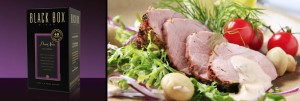 If you’re like me and you want great wine at a great price, sometimes you have to kiss a lot of frogs before you find a prince. (Though, as a positive-type person, I don’t tend to write about most of the frogs because I like to concentrate on recommendations, not warnings.)
If you’re like me and you want great wine at a great price, sometimes you have to kiss a lot of frogs before you find a prince. (Though, as a positive-type person, I don’t tend to write about most of the frogs because I like to concentrate on recommendations, not warnings.)
Anyway, when the Black Box Wines people asked me if I’d like to sample their wines, I remembered trying some good ones years ago. Between their samples and visiting friends, I’ve tried two whites and two reds in the past few weeks. What I like about all the boxed wines is that they really do last for weeks, since there’s no aeration to start degrading the wine quality immediately (which is what happens with wines in bottles). Also, each box contains the same amount as four bottles of wine, so there is some saving in $$ as well as in manufacturing and shipping.
But how are the wines themselves, you ask? I liked the 2013 Pinot Noir (around $20/box) because it’s what you would expect from a reasonably good California Pinot. Made with grapes from several California regions (78% pinot noir, 21% syrah, 1% “dry red” whatever that means), it has strawberry and cherry flavors augmented by some green leafiness, along with acidity and mild tannins — meaning that the wine pairs well with many different types of foods. A medium-long finish, too.
What about the Chardonnay, Riesling and Cabernet Sauvignon? At various gatherings, people seemed to like them but I was unimpressed. They all lacked balance and complexity, and I, personally, would not go back for more. Stick with the Pinot Noir this season…
Three Winter Reds from Rioja Spain: Complexity and Value
Rioja is becoming much more visible in the US with imports of these tempranillo wines increasing 18% last year. And a fact I like: women now make up 35% of the Winemakers’ Association in this (formerly traditional) Spanish region. With many of the wineries ageing their wines for years before release, people buying Reserva and Gran Reserva wines can find value as well as complexity from the Spanish region of Rioja, with beautifully mature wines starting under $20 – pricing which probably won’t last as more people discover these wines, like the 2008 and 2005 wines I sampled recently. Either decant these wines or sip them slowly as their aromas and flavors develop over 30-60 minutes.
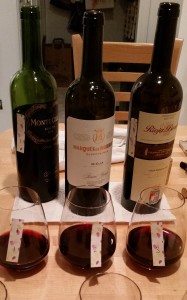
2008 Montecillo Reserva ($17) is a clear, dark red, still feels young, and opens well in the glass – in fact it’s better after breathing for about a half hour, so this is a wine you could decant. Beginning with vanilla and blueberry notes, it opens to caramelized and dark red fruit. The body feels light for a red wine, with strong tannins, fairly well integrated. Good pairing: a plain roast pork or beef with herbed potatoes.
2008 Marques de Murrieta Reserva ($22) feels like autumn or winter, evoking a bit of smokiness. Vanilla and spiced berry, a touch of earthiness. Opening in the glass it becomes fruitier yet spicy: big, velvet, dark fruit, with good acidity for food pairing; steak tips is a good match.
2005 Rioja Bordon, Bodegas Franco-Espanolas Gran Reserva ($23) is earthy and woody, like a cigar box or treasures discovered in an attic. Graceful flavors and structure, light, tannins extremely well integrated. The mild fruit on the palate is just beginning to move to secondary fruit characteristics – from bright freshness to well-aged fruit tea notes, with perfect balance. Smooth…with plain dishes or sipped on its own.
Craft Spirits update from Tales of the Cocktail
After a couple days (and nights) of seminars, tastings and parties at New Orleans’ annual Tales of the Cocktail Conference, one can lose all sense of time. And after a few minutes in the Craft Spirits Tasting Room, one can lose one’s sense of direction too. So it’s somewhat amazing I managed to find my way all around the floor; luckily I had compiled a not-to-be-missed list beforehand.
Over at Brokers Gin, the inimitable Dawson Brothers in their black bowler hats were enjoying plenty of attention from young ladies. This gin is based on a 200 year old formula, and received an enthusiastic reception when it was first introduced at bars and restaurants. 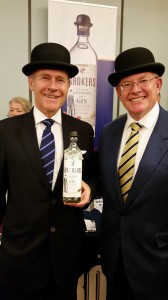
This is echoed by Jim Ruane at Bulleit, who calls bartenders “our partners in chemistry.†Brand ambassadors for Bulleit present a “cheap and cheerful†approach, and have support from the many the mixologists who favor Old Grand-Dad these days. Spread across the country, brand ambassadors are out to educate the people who recommend drinks to customers – and the customers who are increasingly knowledgeable these days.
Citadelle Gin is almost the opposite: emphasizing their French origins and their “solera style†production for their Reserve 2013 Gin, made in Cognac, France. And to make the point about their botanicals, they had brought a lovely selection of herbs and spices in sealed jars — 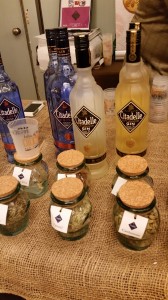 though after a while, for some reason the room police made them remove all the beautiful jars from the table! In this gin, the aromas are as important as the flavors.
though after a while, for some reason the room police made them remove all the beautiful jars from the table! In this gin, the aromas are as important as the flavors.
The well-known Leblon Cachaça also has French origins, created with a master distiller brought from Cognac to Brazil. Here at Tales of the Cocktail, Leblon representatives from Brazil explained their “simple†production process: day one, cut the sugar cane; day two, press the cane and ferment to 8% alcohol; day 3, single distillation of the spirit to 45% alcohol; then age the cachaça in the proper barrels for at least 4 months. Now they are introducing a Reserve Especial with two to three years of age. And in the future they’ll begin to use native Brazilian fruit, like the Leblon acai cachaça due here in 2015.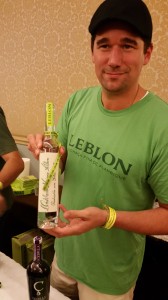
When You Don’t Want to Give up Summer Whites: Wines of Alsace for Dinner
When it has cooled off enough to go back into the kitchen, we’re thinking about cooking again. Maybe grilling sausages, roasting meats, even putting potato gratin back on the menu. But we don’t want to give up our white wines just yet…So here is the third of three suggestions about how to extend summer in your glass, during dinner.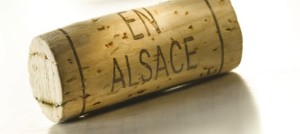
We’re looking toward Alsace for the answer. A hilly region in the northeastern part of France, this area specializes in fine country-style cooking, with an emphasis on “fine,†from hearty meats to dishes with mushrooms and eggs, and even some freshwater fish occasionally.
Start out with a delectable sparkling Cremant d’Alsace – this region is near Champagne, after all – like the nicely balanced Albert Mann Cremant d’Alsace Brut 2011 or the pale rose NV Willm Cremant D’Alsace Blanc de Noirs Brut.
With eggs, mushrooms, grilled meat and fish, move on to two more whites like the light but complex 2012 Willy Gisselbrecht Pinot Blanc or the earthy 2011 Sipp Mack Pinot Gris. And if you can’t find these, go for a dry Alsace Riesling; I recently sampled the lovely, fresh 2012 Mader Riesling and the nicely developed 2007 Becker Riesling Grand Cru Froehn.
With a very light cheese in your cheese course, you might even stray into the classic rose-aromas of the 2011 Hugel Gewurtztraminer; stronger cheese can pair with a late harvest wine like 2001 Trimbach Riesling Cuvee Frederic Emile Vendanges Tardives –as can a light tarte or cake if you prefer a sweeter dessert course.